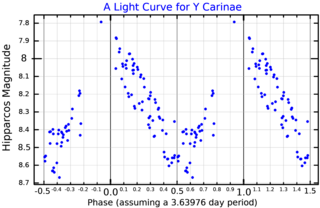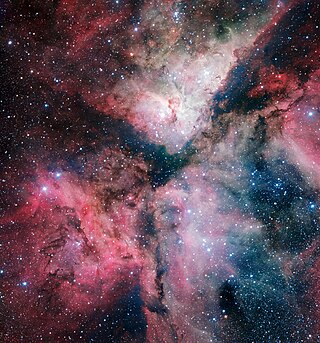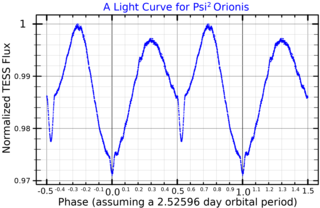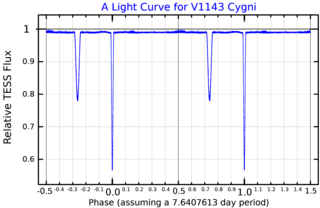
Upsilon Sagittarii is a spectroscopic binary star system in the constellation Sagittarius. Upsilon Sagittarii is the prototypical hydrogen-deficient binary (HdB), and one of only four such systems known. The unusual spectrum of hydrogen-deficient binaries has made stellar classification of Upsilon Sagittarii difficult.

18 Aquilae is a triple star system in the constellation of Aquila. 18 Aquilae is the Flamsteed designation; it also bears the variable star designation Y Aquilae. It has an apparent visual magnitude of 5.07. The distance to this system can be estimated from the annual parallax shift of 6.43 mas, yielding a value of around 510 light-years away from Earth.

AR Aurigae, also known by its Flamsteed designation 17 Aurigae, is a binary star in the constellation Auriga. Based on parallax measurements made by the Hipparcos spacecraft, it is approximately 461 light-years from Earth.

V357 Carinae is an astrometric and spectroscopic binary in the constellation Carina. It is approximately 419 light years from Earth. The mean apparent magnitude of the system is +3.43.

Omicron Cassiopeiae is a triple star system in the constellation Cassiopeia. It is approximately 700 light-years from Earth, based on its parallax. It is visible to the naked eye with a slightly variable apparent magnitude of about 4.5.

Gamma Persei is a binary star system in the constellation Perseus. The combined apparent visual magnitude of the pair is +2.9, making it the fourth-brightest member of the constellation. The distance to this system has been measured using the parallax technique, giving an estimate of roughly 243 light-years with a 4% margin of error. About 4° to the north of Gamma Persei is the radiance point for the annual Perseid meteor shower.

Y Carinae is a Classical Cepheid variable, a type of variable star, in the constellation Carina. Its apparent magnitude varies from 7.53 to 8.48.

HR Carinae is a luminous blue variable star located in the constellation Carina. It is surrounded by a vast nebula of ejected nuclear-processed material because this star has a multiple shell expanding atmosphere. This star is among the most luminous stars in the Milky Way. It has very broad emission wings on the Balmer lines, reminiscent from the broad lines observed in the spectra of O and Wolf–Rayet stars. A distance of 5 kpc and a bolometric magnitude of -9.4 put HR Car among the most luminous stars of the galaxy.

LY Aurigae is a multiple star system in the constellation Auriga. It is an eclipsing binary variable star, dropping in brightness by 0.7 magnitudes every 4 days. The system is around a thousand light years away in the Auriga OB1 stellar association.
Lambda Cygni is a class B5V star in the constellation Cygnus. Its apparent magnitude is 4.54 and it is approximately 770 light years away based on parallax.

1 Geminorum is a star in the constellation Gemini. Its apparent magnitude is 4.15.

1 Persei is an eclipsing binary star in the constellation Perseus. Its uneclipsed apparent magnitude is 5.49. The binary star consists of two B2 type main-sequence stars in a 25.9 day eccentric orbit. The stars are surrounded by a faint cloud of gas visible in mid-infrared, although whether they are the origin of the gas or simply passing through it is unclear.

Gamma Phoenicis is a star system in the constellation Phoenix, located around 71.63 parsecs (233.6 ly) distant.

31 Cygni, also known as ο1 Cygni, Omicron1 Cygni, or V695 Cygni, is a triple star system about 750 light years away in the constellation Cygnus.

QZ Carinae is a multiple star system in the constellation Carina. It is the brightest member of the loose open cluster Collinder 228 and one of the brightest stars in the Carina Nebula. The apparent magnitude is variable from +6.16 to +6.49 with a period of 6 days.

25 Serpentis is a star system in the constellation of Serpens Caput. With an apparent magnitude of 5.37, it is just barely visible to the naked eye. The system is estimated to be some 450 light-years based on its parallax.

ZZ Boötis is a star system in the constellation Boötes. It varies from magnitude 6.79 to 7.44 over five days. Based on its parallax, measured by the Gaia spacecraft, it is about 350 light-years away.

CD Crucis, also known as HD 311884, is an eclipsing binary star system in the constellation Crux. It is around 14,000 light years away near the faint open cluster Hogg 15. The binary contains a Wolf–Rayet star and is also known as WR 47.

Psi2 Orionis a binary star system in the equatorial constellation of Orion. It has an apparent visual magnitude of 4.6, indicating that it is visible to the naked eye. Based upon an annual parallax shift of 2.87 mass, it is roughly 1,100 light years distant from the Sun.

HR 7484 is a binary star system in the northern constellation of Cygnus. It is dimly visible to the naked eye under good viewing conditions, having an apparent visual magnitude of 5.89. Based upon an annual parallax shift of 24.71, it is located 132 light years away. The system is moving closer with a heliocentric radial velocity of −14 km/s.



















